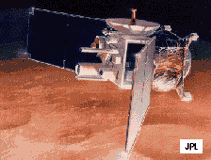MGS
Mars Global Surveyor
 MGS is the first mission of the Mars Surveyor Program, which is an aggressive series of orbiters and landers designed to provide new global and close-up images of Mars. MGS will be a polar orbiting spacecraft at Mars designed to monitor global weather and provide global maps of surface topography and distribution of minerals. After the initial elliptical capture orbit, four months of thruster firings and aerobraking maneuvers will be used to reach the nearly circular mapping orbit. Mapping operations will begin in late January 1998. After collecting data for a full Martian year (approx. 2 Earth years), the spacecraft will be used as a data relay station for future missions for an additional three years.
MGS is the first mission of the Mars Surveyor Program, which is an aggressive series of orbiters and landers designed to provide new global and close-up images of Mars. MGS will be a polar orbiting spacecraft at Mars designed to monitor global weather and provide global maps of surface topography and distribution of minerals. After the initial elliptical capture orbit, four months of thruster firings and aerobraking maneuvers will be used to reach the nearly circular mapping orbit. Mapping operations will begin in late January 1998. After collecting data for a full Martian year (approx. 2 Earth years), the spacecraft will be used as a data relay station for future missions for an additional three years.
Spacecraft
X-band uplink at 500 bps. X-band and Ka-band downlinks at 85.3 kbps max. 1.5m articulated HGA on a 1.5m boom plus 4 LGAs. Dual-mode propulsion system (MMH/NTO) with one 596 N and twelve 4.45 N thrusters. Total propellant load 361 kg. Passive thermal control design. 3-axis stabilized with 10
mrad control and 3 mrad knowledge using reaction wheels, thrusters, sun sensors, horizon sensors, celestial sensors, and IMU. Four articulated 1.7 m x 1.8 m solar panels (2 GaAs, 2 Si) provide 656 watts (980 W max). Two 20 Ahr NiH2 batteries. 1750A-based central computer. Total data storage capacity is 3 gigabits.
Payload
Mars Orbiter Laser Altimeter (MOLA) provides local and global maps of Martian topography
with 2 to 30 meter vertical resolution. Mars Orbiter Camera (MOC) supports study of climate, surface geology, and surface and atmospheric interactions. Camera system includes wide angle (140 degree) and narrow angle (0.4 degree) optics for producing global coverage (7.5 km/pixel), selective moderate resolution images (280 m/pixel) and very selective high resolution (1.4 m/pixel) images.
Magnetometer and Electron Reflectometer for global study of intrinsic magnetic field. Thermal Emission Spectrometer to map the mineral content of rocks, ice caps, and clouds. Radio Science (Ultrastable Oscillator) to study gravitational field, atmospheric refractive indices, and temperature profiles. Mars Balloon Relay to serve as a data relay for planned future surface stations and atmospheric experiments. Ka-Band Link Experiment (KaBLE) to provide Ka-band signal for atmospheric attenutation studies. Total science payload mass is 78 kg.
| Country of Origin | United States |
| Customer/User | NASA |
| Manufacturer(s) | Martin Marietta |
| Size | 1.2 m x 1.2 m x 1.8 m |
| Orbit | 10 months, elliptical capture orbit - 405 km, polar (i=92.5 deg), sun synchronous (2 pm), 2 hour period |
| Design Life | 6 years |
| Related Sites | MGS Home Page JPL MGS Summary |
Launch Facts
| Name | Int'l Desig. | Date | Site | Vehicle | Orbit | Mass(kg) |
| Notes | ||||||
| MGS | 1996-062A | 11/7/96 | ESMC | Delta 2 | Mars | 651 |
| Mars Global Surveyor; will enter Mars orbit to perform long term investigations of Martian surface and atmosphere; payload includes instruments similar to those lost with Mars Observer | ||||||
Information in The Mission and Spacecraft Library is provided without warranty or guarantee. USE AT YOUR OWN RISK.